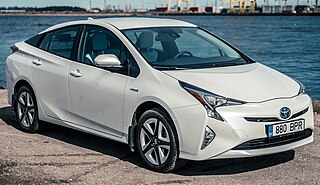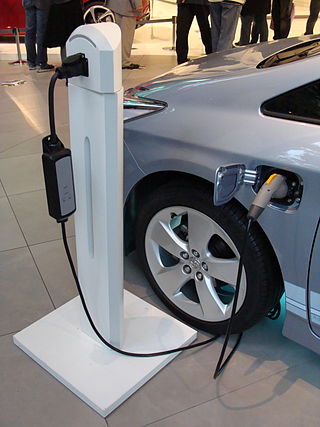Related Research Articles

The Toyota Prius is a car built by Toyota which has a hybrid drivetrain, combining an internal combustion engine with an electric motor. Initially offered as a four-door sedan, it has been produced only as a five-door liftback since 2003.

A hybrid electric vehicle (HEV) is a type of hybrid vehicle that combines a conventional internal combustion engine (ICE) system with an electric propulsion system. The presence of the electric powertrain is intended to achieve either better fuel economy than a conventional vehicle or better performance. There is a variety of HEV types and the degree to which each function as an electric vehicle (EV) also varies. The most common form of HEV is the hybrid electric car, although hybrid electric trucks, buses, boats and aircraft also exist.

The Chevrolet Volt is a plug-in hybrid manufactured by General Motors, also marketed in rebadged variants as the Holden Volt in Australia and New Zealand and the Buick Velite 5 in China, and with a different fascia as the Vauxhall Ampera in the United Kingdom and as the Opel Ampera in the remainder of Europe. Volt production ended in February 2019.

An electric car, battery electric car, or all-electric car is an automobile that is propelled by one or more electric motors, using only energy stored in batteries. Compared to internal combustion engine (ICE) vehicles, electric cars are quieter, have no exhaust emissions, and lower emissions overall. In the United States and the European Union, as of 2020, the total cost of ownership of recent electric vehicles is cheaper than that of equivalent ICE cars, due to lower fueling and maintenance costs. Charging an electric car can be done at a variety of charging stations; these charging stations can be installed in both houses and public areas.

Vehicle recycling is the dismantling of vehicles for spare parts. At the end of their useful life, vehicles have value as a source of spare parts and this has created a vehicle dismantling industry. The industry has various names for its business outlets including wrecking yard, auto dismantling yard, car spare parts supplier, and recently, auto or vehicle recycling. Vehicle recycling has always occurred to some degree but in recent years manufacturers have become involved in the process. A car crusher is often used to reduce the size of the scrapped vehicle for transportation to a steel mill.

The Renault Zoe, known as Renault Zoe E-Tech Electric since 2021, is a five-door supermini electric car produced by the French manufacturer Renault. Renault originally unveiled, under the Zoe name, a number of different concept cars. Initially in 2005 as the Zoe City Car and later as the Zoe Z.E. electric concept was shown in two different versions in 2009 and 2010 under the Renault Z.E. name. A production ready version of the Zoe was shown at the 2012 Geneva Motor Show.

The Mitsubishi i-MiEV is a five-door hatchback electric car produced in the 2010s by Mitsubishi Motors, and is the electric version of the Mitsubishi i. Rebadged variants of the i-MiEV are also sold in Europe by PSA Peugeot Citroën (PSA) as the Peugeot iOn and Citroën C-Zero. The i-MiEV was the world's first modern highway-capable mass production electric car.
The 2008–2010 automotive industry crisis formed part of the 2007–2008 financial crisis and the resulting Great Recession. The crisis affected European and Asian automobile manufacturers, but it was primarily felt in the American automobile manufacturing industry. The downturn also affected Canada by virtue of the Automotive Products Trade Agreement.
A scrappage program is a government incentive program to promote the replacement of old vehicles with modern vehicles. Scrappage programs generally have the dual aim of stimulating the automobile industry and removing inefficient, more polluting vehicles from the road. Many European countries introduced large-scale scrappage programs as an economic stimulus to increase market demand in the industrial sector during the global recession that began in 2008.

A plug-in electric vehicle (PEV) is any road vehicle that can utilize an external source of electricity to store electrical energy within its onboard rechargeable battery packs, to power an electric motor and help propelling the wheels. PEV is a subset of electric vehicles, and includes all-electric/battery electric vehicles (BEVs) and plug-in hybrid electric vehicles (PHEVs). Sales of the first series production plug-in electric vehicles began in December 2008 with the introduction of the plug-in hybrid BYD F3DM, and then with the all-electric Mitsubishi i-MiEV in July 2009, but global retail sales only gained traction after the introduction of the mass production all-electric Nissan Leaf and the plug-in hybrid Chevrolet Volt in December 2010.
The Retire Your Ride program was a voluntary Canadian scrappage program created to reward Canadians for permanently retiring a vehicle made in 1995 or earlier for a wide range of rewards, such as a public transit pass or C$300. The program ended on March 31, 2011. By January 2011, the program had surpassed its original targets and had permanently retired over 120,000 vehicles and reduced thousands of tonnes of smog-forming emissions. The program was available in provinces across Canada. Some automakers had started their own complimentary auto retirement programs with rewards on top of the federal program's rewards in an effort to increase vehicle sales in Canada.

The adoption of plug-in electric vehicles in the United States is supported by the American federal government, and several states and local governments. As of December 2021, cumulative sales in the U.S. totaled 2.32 million highway legal plug-in electric cars since 2010, led by all-electric cars. The American stock represented 20% of the global plug-in car fleet in use by the end of 2019, and the U.S. had the world's third largest stock of plug-in passenger cars after China (47%) and Europe (25%).

The Toyota Prius Plug-in Hybrid is a plug-in hybrid liftback manufactured by Toyota. The first-generation model was produced from 2012 to 2016. The second-generation model has been produced since 2016. Production of the third-generation model is expected to commence in 2023.

Electric car use by country varies worldwide, as the adoption of plug-in electric vehicles is affected by consumer demand, market prices, availability of charging infrastructure, and government policies, such as purchase incentives and long term regulatory signals.

Government incentives for plug-in electric vehicles have been established around the world to support policy-driven adoption of plug-in electric vehicles. These incentives mainly take the form of purchase rebates, tax exemptions and tax credits, and additional perks that range from access to bus lanes to waivers on fees. The amount of the financial incentives may depend on vehicle battery size or all-electric range. Often hybrid electric vehicles are included. Some countries extend the benefits to fuel cell vehicles, and electric vehicle conversions.

The adoption of plug-in electric vehicles in the France is actively supported by the French government through a bonus–malus system through which provides subsidies towards the purchase of all-electric vehicles and plug-in hybrids with low CO2 emissions. The government also provides non-monetary incentives; subsidies for the deployment of charging infrastructure; and long term regulations with specific targets. Additionally, France passed a law in December 2019 to phase out sales of cars that burn fossil fuels by 2040.

The fleet of light-duty plug-in electric vehicles in Japan totaled just over 300,000 highway legal plug-in electric vehicles in circulation at the end of 2020, consisting of 156,381 all-electric passenger cars, 136,700 plug-in hybrids, and 9,904 light-commercial vehicles.

The stock of new energy vehicles in China is the world's largest, with cumulative sales of 5.5 million units through December 2020. These figures include passenger cars and heavy-duty commercial vehicles such buses and sanitation trucks, and only accounts for vehicles manufactured in the country. Of these, there were 4.9 million new energy vehicles in use at the end of 2020, accounting for 1.75% of all vehicles in circulation in China.

The adoption of plug-in electric vehicles in the United Kingdom is actively supported by the British government through the plug-in car and van grants schemes and other incentives. About 745,000 light-duty plug-in electric vehicles had been registered in the UK up until December 2021, consisting of 395,000 all-electric vehicles and 350,000 plug-in hybrids. Until 2019, the UK had the second largest European stock of light-duty plug-in vehicles in use after Norway.

The adoption of plug-in electric vehicles in Europe is actively supported by the European Union and several national, provincial, and local governments in Europe. A variety of policies have been established to provide direct financial support to consumers and manufacturers; non-monetary incentives; subsidies for the deployment of charging infrastructure; and long term regulations with specific targets. In particular, the EU regulation that set the mandatory targets for average fleet CO2 emissions for new cars has been effective in contributing to the successful uptake of plug-in cars in recent years
References
- ↑ "Plug-in car grants: eligibility and applications". GOV.UK. Retrieved 20 August 2019.
- ↑ Reed, John (23 April 2009). "Mixed response greets car-scrapping bonus". Financial Times. Retrieved 16 July 2009.
- 1 2 Webster, Ben (23 April 2009). "Car-scrap scheme payout is a cheat at half the price". The Times. London. Retrieved 9 April 2010.
- ↑ "Some initial reactions to Budget 2009" (PDF). Institute for Fiscal Studies. Retrieved 10 March 2010.
- ↑ Kumar, Nikhil (5 March 2010). "Car sales rise again as end of scrappage looms" . The Independent. London. Archived from the original on 11 August 2022. Retrieved 9 April 2010.
- ↑ "Vehicle scrappage scheme drives down emissions of new cars". The Guardian. London. 9 March 2010. Retrieved 10 March 2010.
- 1 2 Hudson, Paul (28 February 2010). "£5,000 grant to buy plug-in electric cars". The Telegraph. London. Retrieved 10 March 2010.
- ↑ Moore, Matthew (2 February 2010). "Radio 'scrappage' scheme to boost sales of digital sets". The Daily Telegraph. London. Retrieved 10 March 2010.
- ↑ "UK moves towards car scrap scheme". BBC News. 12 April 2009. Retrieved 10 March 2010.
- ↑ "Car scrappage scheme considered for ailing UK motor industry" . The Independent. London. 16 February 2009. Archived from the original on 11 August 2022. Retrieved 9 April 2010.
- ↑ Winnett, Robert (21 April 2009). "Owners of older cars to be offered cash to trade in vehicles". The Telegraph. London. Archived from the original on 20 April 2010. Retrieved 10 March 2010.
- ↑ "Q&A: The new car scrappage scheme". BBC News. 28 September 2009. Retrieved 9 April 2010.
- ↑ Wintour, Patrick (28 September 2009). "Mandelson announces extension of car scrappage scheme". The Guardian. London. Retrieved 9 April 2010.